Euthydemid › Excalibur › Greek Theatre Architecture » Origins and History
Articles and Definitions › Contents
- Euthydemid › Ancient History
- Excalibur › Ancient History
- Greek Theatre Architecture › Antique Origins
Ancient civilizations › Historical places, and their characters
Euthydemid › Ancient History
Definition and Origins
The Euthydemids were a Greco-Bactrian and Indo-Greek dynasty of approximately 25 kings, named after its founder Euthydemos. The dynasty lasted between circa 230 BC and 10 BC, according to numismatic evidence. The numismatic emblems which characterize most this dynasty are Athena Alkidemos [Defender of the peoples] and Herakles. Euthydemos, became king by overthrowing the Greco-Bactrian king Diodotos II circa 230 BC. He then succeeded to resist against the Seleucid king Antiochos III who eventually recognized Euthydemos as the king of Bactria. He and his son Demetrios began to conquer India and thus became famous. They are mentioned by Greek and Latin classical historians, while their successors were divided since 190 BC and, with some exceptions such as the early Indo-Greek kings Agathocles and Pantaleon, faded into obscurity. Around 171 BC the Euthydemid dominion of Greco-Bactrian and Indo-Greek kingdoms were shaken by the rebellion of Eucratides, who quickly conquered most regions, except the domains of king Menander. From then on the Euthydemid and Eucratid dynasties were waging continuous at war with each other, which lasted for 90 years and tore the Greco-Bactrian and Indo-Greek kingdoms apart. The powerful king Menander succeeded to push Eucratides back to Bactria around 155 BC, but the Euthydemids never fully regained control of Bactria. When the Yuezhei c.145 BC invaded Bactria, the Eucratids retreated into the Indo-Greek possessions. An Euthydemid presence remained in India until 80 BC;when both dynasties were worsened by the powerful Indo-Saka king Maues. In defense against Maues an alliance between the two Greek dynasties seems to have taken place, led by Amyntas. After the death of Maues, numismatic evidences suggests that only the Euthydmids subsequently ruled the Indo-Greek kingdoms, until evidence of Greek presence in India fades around 10BC.
Excalibur › Ancient History
Definition and Origins

Excalibur is the sword of King Arthur in Sir Thomas Malory's iconic work Le Morte D'Arthur published in in 1485 CE. The sword was originally introduced in Geoffrey of Monmouth's History of the Kings of Britain (1136 CE) as Caliburnus (or Caliburn) and further developed by later writers before Malory immortalized it in his work. The sword, from its first appearance, is a powerful weapon in the hands of a skilled warrior and retains that reputation in every story which features it.
As with many other magical or powerful swords in legend or mythology, it is identified with a single hero and should not be allowed to fall into the hands of an enemy owing to its inherent power. In the case of Excalibur, when Arthur is dying of his wounds following his battle with Mordred, it must be returned to its source, the Lady of the Lake, rather than being entrusted to whichever knight - no matter how noble - might succeed Arthur as king.
This rule does not always hold true in every version of the legend, however. In the poem Conte du Graal, Provencal poet Chretien de Troyes (c. 1130 - c. 1190 CE) makes Excalibur (called Escalibor ) Sir Gawain's weapon. In the Vulgate Cycle(1215-1235 CE) and the Post-Vulgate Cycle (c. 1230-1245 CE) Arthur presents Gawain with Excalibur who then loans it to Lancelot for his defense of Guinevere. Gawain then returns the sword to Arthur for his final battle with Mordred and, afterwards, it must be returned to the Lady of the Lake.
SWORDS IN MYTHOLOGY
The concept of a "sword of power" did not originate with the Arthurian legend. Greek mythology mentions a number of magical swords and, especially, the harpe used by the titan Cronos to overthrow his father Uranus. Julius Caesar 's sword, the Crocea Mors was supposed to have supernatural powers as was the Sword of Mars wielded by Attila the Hun. The Gianjiang and Moye swords of the Chinese Spring and Autumn Period are also supposed to have been imbued with great power by their makers.
EXCALIBUR IS FREQUENTLY ASSOCIATED WITH ANOTHER ARTHURIAN MOTIF, THE SWORD IN THE STONE, BUT THESE ARE ACTUALLY TWO DIFFERENT SWORDS.
In the biblical Book of Genesis, after the Fall of Man, God sets his cherubim to stand watch to the east of the Garden of Edenalong with a flaming sword "which turned every way" to prevent Adam and Eve from returning. The Shinto storm god Susanoo finds a magical sword in the tail of a dragon and this eventually became part of the Japanese imperial regalia. Norse mythology frequently makes use of magic swords, such as Gram, the weapon of Sigmund and his son Sigurd and the Celtswove a number of magical swords into their tales, including the Claiomh Solais ( kleeve sollish ), the Sword of Light which triumphs over darkness. The 11th century CE Spanish hero El Cid was claimed to have two magic swords and the 8th century CE French champion Roland wielded his famous blade Durendal and fell with it defending the Pass of Roncevaux in the epic Song of Roland.
Although there are these precedents for earlier magical or supernaturally powerful swords, Excalibur is arguably the most famous. It is frequently associated with another Arthurian motif, the Sword in the Stone, but these are actually two different swords. In some versions of the legend, the Sword in the Stone is broken in Arthur's first battle and is replaced by Excalibur while, in others, the Sword in the Stone substantiates Arthur's right to rule (as only he can draw the blade from the rock) as the son and successor of Uther Pendragon while Excalibur serves as a symbol of his power as king.
THE FAMOUS NAME & ORIGIN
The name Excalibur may originate in the work Culhwch and Olwen from the Mabinogion, a collection of Welsh legends, if one accepts a date of composition as c. 1100 CE. The Mabinogion only exists in manuscripts from the 13th and 14th centuries, however, and some scholars date it at 1200 CE. In this tale Arthur's sword is called Caledvwich which derives from the Latin chalybs ("steel" or "iron") and means "hard cleft". Caledvwich as the name for a sword of power most likely comes from the mythological Irish blade Caladbolg (which means "voracious") carried by the king Fergus mac Roich in the Ulster Cycle of Irish mythology.

King Arthur & the Lady of the Lake
Geoffrey of Monmouth calls Arthur's sword Caliburnus in Medieval Latin which is a more direct use of the Latin chalybs as "steel" but denotes a particularly hard or effective blade. Essentially, by the time Geoffrey was writing, the name of Arthur's blade would be understood as "famous sword" or "great sword" because of the earlier associations of chalybs with mythological weapons.
The French poet Wace (c. 1110-1174 CE) translated Geoffrey's work into Old French vernacular and re-named the swordChaliburn. Chretien de Troyes changed the name to Escalibor. When the Arthurian legend was translated into English, Chaliburn / Escalibor became Excalibur. Malory, drawing on the Vulgate Cycle, calls Arthur's sword Excalibur shortly after Arthur has found and drawn the Sword in the Stone, linking the name with that weapon, and this association has stuck. Later, however, once this first sword is broken in battle, it is made clear that Arthur must receive the "true Excalibur" from a mystical source, the Lady of the Lake, and Merlin (who seems to be the magical force behind both swords) guides him to the place where it will be offered to him. No explanation is given as to the meaning, power, or origin of the sword and, in fact, Malory focuses more attention on the scabbard.
Whether presented as the Sword in the Stone or given by the Lady of the Lake, it is clear Excalibur comes from another realm.This motif follows from an established paradigm in Celtic lore of magical weapons, such as the spear of Cuchulain or the sword of Fergus mac Roich, having been forged in a mystical realm. The same device, however, is used in legends from many cultures around the world. The great swords of Gianjiang and Moye, for example, also have mystical origins. In the case of Excalibur, the sword develops from a mighty weapon to a symbol of divinely inspired justice and redemption. When the weapon is first mentioned in Geoffrey of Monmouth's work, no magical attributes are ascribed to it.
THE POWER OF THE SWORD
In Book IX of History of the Kings of Britain, Caliburn is first referenced as "the best of swords, that was forged within the isle of Avallon" and is listed by Geoffrey along with Arthur's other gear as an item of particular importance. As Arthur is preparing to meet the Saxons in battle at Bath, Geoffrey writes:
He did set upon his head a helm of gold graven with the semblance of a dragon. Upon his shoulders, moreover, did he bear the shield that was named Pridwen, wherein, upon the inner side, was painted the image of holy Mary, Mother of God, that many a time and oft did call her back unto his memory. Girt was he also with Caliburn, best of swords, that was forged within the Isle of Avallon; and the lance that did grace his right hand was called by the name Ron, a tall lance and stout, full meet to do slaughter withal. (188)
The Saxons have broken trust with Arthur after they had sworn a treaty of peace and so the battle is a matter of personal honor as well as a necessary defense of his realm. Geoffrey describes a hard-fought battle in which the Saxons hold the high ground and inflict heavy casualties on the Britons under Arthur. The Saxons continue to hold their position until the day is almost gone and then Arthur has finally had enough and leads a final charge on their position himself. Geoffrey writes:
Arthur waxed wroth at the stubborness of their resistance, and the slowness of his own advance, and drawing forth Caliburn, his sword, crieth aloud in the name of Holy Mary, and thrusteth him forward with a swift onset into the thickest press of the enemy's ranks. Whomsoever he touched, calling upon God, he slew at a single blow, nor did he once slacken in his onslaught until that he had slain four hundred and seventy men single-handed with his sword Caliburn. This, when the Britons beheld, they followed him up in close rank dealing slaughter on every side. (189)
Excalibur is described in more or less the same way every time it appears in a story. In Malory's work, when Arthur is attacked by King Lot, he is at first beaten until he unleashes the power of his sword:
Therewith King Lot smote down King Arthur. With that, his four knights rescued him and set him on horseback;then he drew his sword Excalibur, and it was so bright in his enemies' eyes that it gave light like thirty torches.Therewith he put them back and slew many people. (13)
Arthur confronts Lot early in Malory's version of the legend and it seems as though Excalibur is the same sword as the one Arthur earlier drew from the stone. This has caused confusion between two weapons which are often identified as the same but are not.
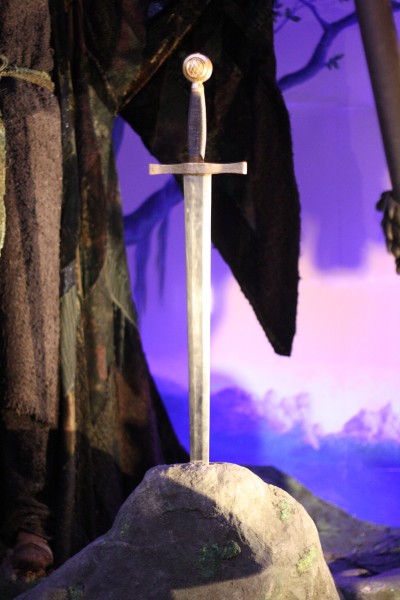
Excalibur, from the 1981 Film Excalibur
THE SWORD IN THE STONE
The concept of the Sword in the Stone was added to the Arthurian legend by the French poet Robert de Boron (12th century CE) in his Merlin. Robert de Boron presents the sword as anchored in an anvil which later writers changed to a stone. The Vulgate Cycle of the legend differentiates between the sword that Arthur drew from the stone and Excalibur and this tradition is continued in the Post-Vulgate Cycle and repeated in Malory's work.
Although Arthur's sword is identified as Excalibur early in Malory's version, it becomes clear that it is not the true Excalibur since this sword is broken in Arthur's fight with King Pellinore. Pellinore gets the best of Arthur after his sword breaks and tells him to yield but the young king will not. In order to save both their lives, Merlin puts Pellinore to sleep and then takes Arthur to receive the true Excalibur from the Lady of the Lake. Arthurian scholar Norris J. Lacy writes:
In certain texts (and in popular Arthurian lore), Excalibur is also the Sword in the Stone, but such an identification is incompatible with the tradition, found, for example, in the Post-Vulgate Cycle and Malory, whereby the sword is given to Arthur (and finally taken from him) by a hand in the lake. (176)
Since Excalibur is defined by its power and strength it cannot be the same weapon which is broken in Arthur's encounter with Pellinore. Even so, according to Merlin, it is not Excalibur which is so extraordinary but its scabbard. Merlin asks Arthur, "Which pleases you better, the sword or the scabbard?" and Arthur answers, "The sword pleases me better." Merlin then rebukes him:
"Ye are the more unwise," said Merlin, "for the scabbard is worth ten of the sword. While ye have the scabbard upon you, ye shall never lose any blood, be ye ever so sorely wounded. Therefore always keep the scabbard with you." (37)
This detail becomes significant later in Malory's version of the story when Arthur's sister, Morgan le Fay, steals the scabbard.She had hoped to defeat Arthur through magic by pitting her lover Sir Accolon against Arthur, giving Accolon the true Excalibur and Arthur a fake (a plot device taken almost directly from the Irish Ulster Cycle ). When Arthur's sword breaks he knows it is not Excalibur and manages to defeat and kill Accolon. Morgan takes the magical scabbard in revenge and throws it into a lake;thus dooming Arthur in his final battle with Mordred.
SIGNIFICANCE OF EXCALIBUR
The sword has become more famous than the powerful scabbard and continues as a symbol of Arthur's virtue and power.Later works, including El Cid and the Song of Roland, draw on the symbolism of Excalibur for their heroes. JRR Tolkien's famous trilogy of The Lord of the Rings relies on the symbolism of a sword of power which is broken and must be made whole to convey the concept of the return of the rightful king; a plot device which is similar to the Sword in the Stone motif where the land suffers after Uther Pendragon's death until the legitimate king is able to draw the magical sword from the stone.

Sir Bedevere Returns Excalibur to the Lake
More than simply a literary device, however, Excalibur has come to represent the noblest aspects of the Arthurian legend.Although it is always described as a sword of power, that power is wielded in the best interests of the people, of justice, not in the self-interest of the king. Excalibur is given to Arthur through magical means, by the Lady of the Lake; it is not a weapon forged in this world but in another. The sword comes from this other realm and, once Arthur is defeated and dying, it must be returned there. This motif is not unique to the Arthurian legend but is borrowed from Celtic tradition in which the magical weapon must be returned to its source.
In some versions of the story, the knight Sir Girflet, who has survived the final battle between Arthur and Mordred, is given the task of throwing Excalibur back into the lake; in Malory this falls to Sir Bedevere. Whether Girflet or Bedevere, Arthur's command that Excalibur be returned to where it came from goes unheeded twice since the knight he sends on the errand cannot see the sense in throwing away such a noble and powerful weapon. This failure on the part of one of Arthur's most trusted companions resonates with the Christian story of the betrayal of Christ by Judas, as it is intended to, and points to the same meaning: that the world cannot understand or appreciate the efforts of the divine will to help it rise to more than what it thinks it can be.
Greek Theatre Architecture › Antique Origins
Ancient Civilizations
The ancient Greeks built open-air theatres where the public could watch the performances of Greek comedy, tragedy, and satyr plays. They then exported the idea to their colonies throughout the Aegean so that theatres became a typical feature of the urban landscape in all Greek cities. The Romans continued and expanded on the concept, added a monumental backstage, and generally made the structure more grandiose. The large semi-circular structures, still with their excellent acoustics, are visible today at many archaeological sites, and several of them remain in use not only for modern concerts and performances but also for festivals of ancient Greek drama.
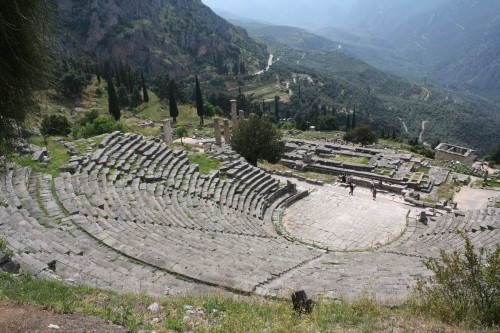
Theatre of Delphi
EARLY THEATRES
The earliest Greek theatres can be traced back to the Minoan civilization on Crete where a large open space with stepped seating can still be seen today at the site of Phaistos. Evolving from a stage area of tramped earth set before a natural hill on which spectators might sit and watch religious ceremonies, the early theatres appeared from the 6th century BCE and were built wholly of wood. Early examples may also have had a rectangular arrangement of seating (as at Thoricus and Trachones in Attica) but this soon developed into the semi-circular arrangement which allowed more people to see the spectacle and have a better view.
THE OLDEST THEATRE IS THAT OF DIONYSOS ELEUTHEREUS ON THE SOUTH SLOPE OF THE ACROPOLIS OF ATHENS.
According to 5th-4th century BCE Greek pottery decoration the stage was built around one metre above the ground and had steps at the front. Actors performed on the stage which had an entrance on the left and right sides and from a single central doorway (soon expanded to three) in the scenery behind, usually made to resemble a temple, palace, or cave. The use of painted scenery is also very likely. The stage scene could also have a top platform from which actors could play gods speaking down upon the audience and actors alike. The excitement of performances was enhanced with one or two technical additions.A wheeled platform ( ekkylema ) was pushed out of the doorway and used to dramatically reveal new scenery, and a crane ( mechane ) was situated to the right of the stage and used to lift actors who were playing gods or heroes.
FROM WOOD TO STONE
The oldest theatre is that of Dionysos Eleuthereus on the south slope of the acropolis of Athens which was first built in the 6th century BCE. The theatre would host the Great Dionysia, held each year in March/April, during the month of Elaphebolion, where the most famous playwrights such as Euripides, Sophocles, and Aristophanes presented their plays in competition.Its evolution was typical of most Greek theatres in other cities. At the end of the 5th century BCE a rectangular stage building was added with wings on each side. Still, only the front seats were made of stone and the rest of wood. Monumental entrances were built at the sides of the stage for the public to enter.

Theatre of Dionysos Eleuthereus, Athens
In the 4th century BCE all the seats were made in stone (benches) and walkways made between sections of seats to facilitate access. Stone ramps were added to the entrances to allow the audience to leave the theatre in good order. Finally, the stage scenery or backdrop also came to be made of stone and faced with semi-columns. The theatre had finally acquired the architectural form which became more or less the standard across the Greek and later Roman worlds.
ARCHITECTURAL ELEMENTS
Auditorium – the area between the stage and seats.
Cavea (theatron) – the approximately semi-circular bank of seating.
Cunei – the wedge-shaped sections of seats separated by horizontal walkways and vertical steps.

The Theatre of Epidaurus
Diazoma – the horizontal walkways between tiers of seats.
Orchestra - the flat area where the chorus stood, sang, and danced.
Paradoi – the monumental passageways and gateway entrance on each side of the auditorium.
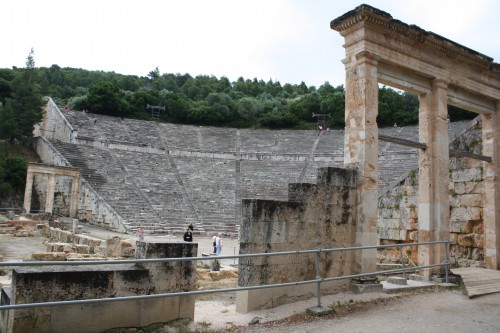
Theatre Parodoi, Epidaurus
Paraskenia – the wings at the end of each side of the skene stage building.
Proedria – throne-like seats in the front rows for VIPs.
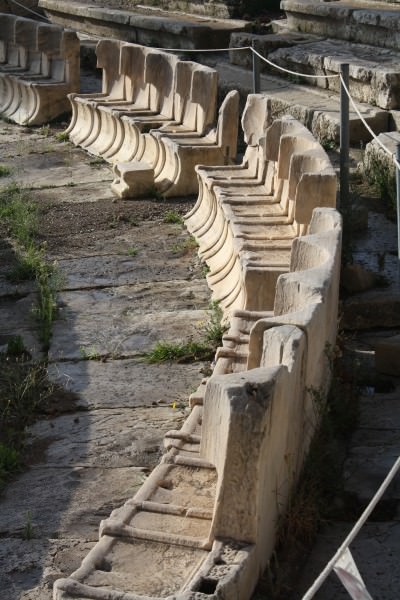
Seats of the Theatre of Dionysos, Athens
Proskenion – a platform supported by columns in front of the skene initially decorative but then used as a second, higher stage.
Skene – the backdrop of the stage. First merely a tent or curtained area for actors to change costumes but later a more permanent structure which also acted as scenery for the performance.
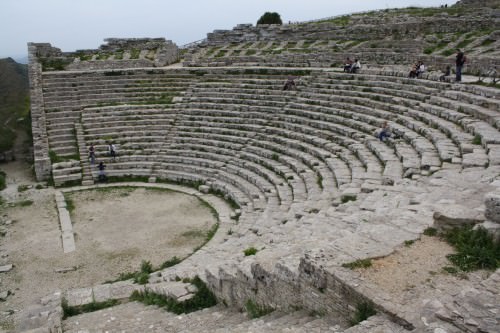
Theatre of Segesta
OUTSTANDING EXAMPLES
We have already mentioned the theatre of Dionysos Eleuthereus, the very home of Greek theatre, which still has its front row of 67 proedria seats. The 2nd-3rd century CE reliefs of the bema (low speaker's platform) are still in place too and show scenes from the myths of Dionysos. Many other theatres, though, were built across Greece and the Aegean as the Greeks themselves colonized Ionia and Magna Graecia. One of the largest is the theatre of Argos which had 81 rows of seats and a capacity for 20,000 spectators. Perhaps the 3rd-century BCE theatre at Ephesus was larger still, with a capacity of 24,000.One of the best preserved, and with surviving paradoi, is at Epidaurus which was first built in the 4th century BCE and which is the site of an important annual festival of ancient Greek Drama.
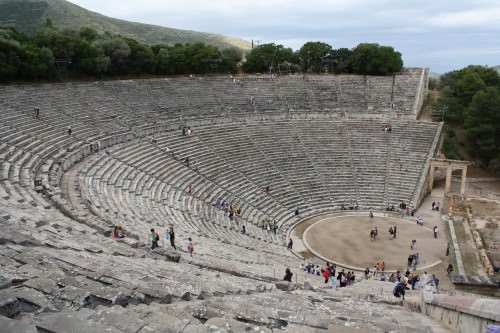
Theatre of Epidaurus
Greek architects liked to site their theatres in such places that gave the audience a spectacular view not just of the actors on the stage but also the landscape behind. The 2nd-century BCE theatre at Pergamon in modern Turkey built by Eumenes II must hold one of most breathtaking positions, as it is, perched on a steep hillside looking down on the plain of the river Caicus far below. Segesta in Sicily, built from the 4th century BCE, boasts another example of a theatre seat with a view, this time looking out to the sea and the Gulf of Castellamare. For sheer picturesque location, though, it is difficult to challenge one of the earliest, the theatre at Delphi. Built in the 4th century BCE and quite small, with only 5,000 seats, it nestles on the wooded sides of Mt. Parnassus and commands a view of the whole green-carpeted valley below.
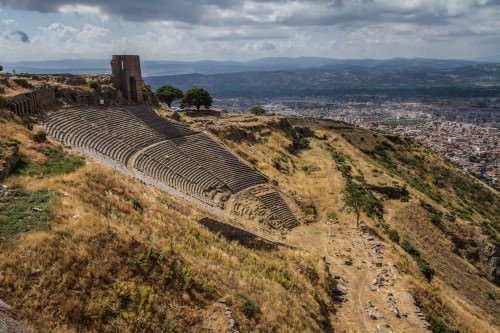
Theatre of Pergamon
ROMAN ADDITIONS
The Romans greatly admired Greek architecture and, in typical fashion, they copied and enhanced the idea of tightly-packed public spectacles. They enlarged the permanent scenery behind the stages of Greek theatres making it into a multi-story backdrop ( scaenae frons ) that joined the sides of the cavea. Nero, for example, added a monumental Roman-style stage building to the Dionysos Eleuthereus theatre which reduced the now marble stage area to its semi-circular form still seen today. A low speaker's platform ( bema ) was added to the enlarged stage too in the 2nd or 3rd century CE. The Romans also paved the orchestra, sometimes added an awning roof ( vela ), built substructures under the seating, and generally added more decoration to theatres by adding monumental statues, exotic marble columns, and relief carvings to the stage area. With their high backstage and covered roof, the enclosed and almost claustrophobic atmosphere of the Roman theatre would more and more come to resemble the modern theatres of today.
LICENSE:
Article based on information obtained from these sources:with permission from the Website Ancient History Encyclopedia
Content is available under License Creative Commons: Attribution-NonCommercial-ShareAlike 3.0 Unported. CC-BY-NC-SA License